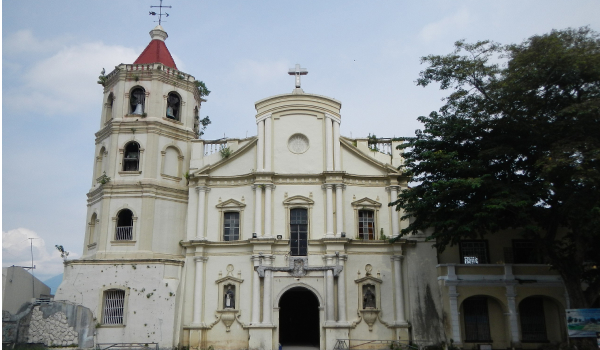
One of the social characteristics of the diocese can be categorized from the provincialism (Tagalog) into a cosmopolitan mixture of many regional cultures. Understanding the Filipino society, it has widely recognized the reality of regionalism which calls for a profound attention in the evangelization and socio-cultural settings and understanding. Lingual reality is not a hindrance because Filipino or Tagalog dialect is widely spoken and used but the mentality that is inherent to their local origin creates a clash of regional culture.
The Diocese of San Pablo, erected through the Apostolic Letter "Ecclesiarum perampla" on Nov. 28, 1966, was the last of the four ecclesiastical units carved out of the Diocese of Lipa since this was created as a separate diocese from the Archdiocese of Manila in 1910. The first was the Apostolic Prefecture of Mindoro in 1936 then the Diocese of Lucena in 1950, followed by the Prelature of Infanta in 1951 and finally the Diocese of San Pablo in 1967, comprising the City of San Pablo and the whole province of Laguna.
The Diocese of San Pablo was created, there were only six (6) vicariates, thirty-three (33) parishes, and forty (40) priests spreading the word of God. Its first bishop was Bishop Pedro N. Bantigue who served the diocese for almost 29 years. He was succeeded by the Bishop Francisco C. San Diego by taking the canonical possession of the diocese on Aug. 22, 1995. After almost eight (8) years of service in the diocese, he accepted his appointment as the first Bishop of Pasig. For almost a year, the diocese was sede vacante, Bishop Bernardino C. Cortez was the elected diocesan administrator until the appointment of the Bishop Leo M. Drona, SDB, D.D., Third Bishop of San Pablo, on May 14, 2004.
After forty-three (43) years since its erection, the Diocese has 4 episcopal districts, 12 vicariates and 80 parishes. There are five (5) male Religious congregations who administer 10 of these parishes. Presently, the Diocese of San Pablo has 124 diocesan priests, 12 male religious congregations and 33 congregations of religious women. The diocese has a Diocesan Seminary - St. Peter's College, located in the seat of the diocese and the other one is in Tagaytay - San Pablo Theological Formation House. Including many lay movements and religious organizations, the diocese of San Pablo is a dynamic particular church.
Principal Characteristics
Laguna is endowed with abundant natural resources. Its forests are filled with bamboo, rattan, and soft hardwood. Its wide fields and vast forests are ideal for growing rice, coconuts, vegetables, tropical fruits, orchids, and other ornamental flowers and exotic plants. The province is also rich in mineral resources such as clay, jasper and basalt glass. There are about 40 rivers in Laguna with a total area of almost 0.5 square kilometers. In the forests of Mount Makiling and in the waters of Laguna de Bay are an abundance of flora and fauna. The Laguna de Bay has an approximate area of 3, 800 square kilometers broken down into 2,900 square kilometers of land and 900 square kilometers of lake proper with 220 kilometers shoreline.
Laguna's greatest natural resource is water. It has an estimated 300 million US gallons (1,100,000 m3) of underground water, capable of generating energy for Laguna's expanding power needs. At least seven principal water basins in the province with a total of 5,773 square kilometers drainage area and 1,316 square kilometers level area provide an estimated 9.238 m3 total run-off annually. Crop Production, Livestock and Poultry Production as well as Fishing are the prominent agricultural activities in the province.
Considering the geographical location of the diocese, this particular church lies prominently in the area of industrialization, business and commerce which leads into a very rapid influx of local migrants coming from various provinces of the country. It is quite noticeable that the leading migrants are the youth, who after earning their education, are now engaged in manual, computer, and technical work. Work that includes Ecotourism enterprises; Convention centers; Coconut inter-cropping; Forest Trees, Cutflowers & ornamentals; Fruit & vegetable processing; Herbal medicines; Herbal essences; Gifts and housewares; Metalcraft (Industrial equipment, Engines, Surgical instruments, Agricultural machinery, tools); Service Facilities (Packaging, Warehousing, Trucking services, dryers); Electronics (Consumer electronics, Telecommunications, Computers & peripherals, Semi-conductors); and Garments and footwear; Agriculture; Fishing; Forestry; Tourism.
Aside from this growing manpower, the rise of educational centers is also evident. Famous Catholic educational institutions are branching out and settling in the province especially in the first and second districts not excluding the other entities with the same mission. A threatening factor that affects the flourishing Catholic education is the simultaneous rise of sectarian and non-sectarian education centers wherein many Catholics receive their formal education. Having in mind that the country is pre-dominantly Catholic, it is through these institutions that indoctrination occurs not mentioning the zeal in proselytism. Not undermining the catechetical insertion in public schools which Catholic doctrines are given as part of the school activity, those Catholics who receive secondary school or high school education are insufficiently taught due to insufficiency of personnel who can bring the teachings of the Church to them.
Among the prevailing problems that destroy our society as diocese which is equivalent to other dioceses characterized by economic development are drug addiction, misconception of sex, moral and religious relativism, housing and education. The manipulation of social communication especially both in television and film industries does great harm to the morale of the people. With the modern and sophisticated media access and the prevailing youth potent to the use of these equipment and techniques, the gravity of spreading is calamitous that families are now experiencing its effects.
Comparing the moral standard of the diocese to other part of the country, San Pablo Diocese can still boast of its relatively high moral standard. But at the same time frightened by the devastating impact that secularism brings and how the government through its population birth control programs educates children the sense of birth control and abortion.